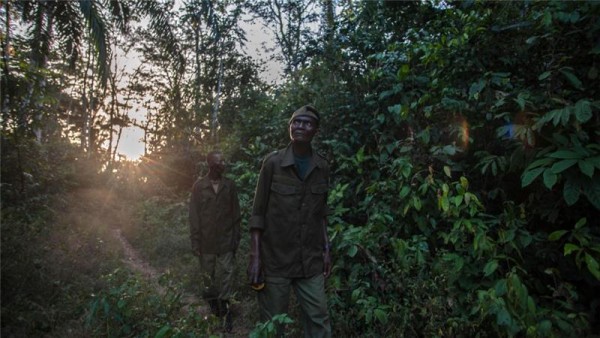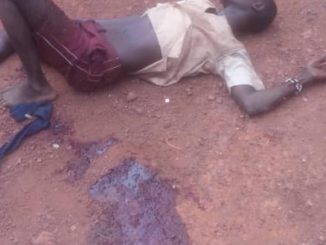
Former Kamajor militia fighters work to protect and breathe life back into the endangered Gola Forest.
Aurelie Marrier d’Unienville | 10 Apr 2016 10:35 GMT | Environment, Africa, Sierra Leone
The rangers patrol the park in 12-day shifts, walking nearly 50km a day and sleeping in hammocks at night [Aurelie Marrier d’Unienville/Al Jazeera]
Gola Forest, Sierra Leone – Beneath the dense forest canopy, Vandi Konneh carefully picks his way along the rocky footpath. Beads of sweat gather at his temples as he scans the undergrowth for signs of the poachers who roam here. Working as a park ranger in the remote Gola Forest in southern Sierra Leone is a dangerous business, but Konneh is not afraid.
A muscular 36-year-old with piercing eyes and high cheekbones, Konneh is one of a small band of ex-militia fighters from the country’s 11-year civil war, who now use their skills and experience to preserve the forest.
Walking deeper into the trees, Konneh is alert as he examines the nearby plant life.
“If we encounter any armed poachers, lie flat on the ground,” he says. Just a month earlier, another ranger was treated in hospital after being slashed with a machete during an encounter with poachers.
A global biodiversity hotspot, the national park has more than 1,000 plant species, over half of which are endemic, as well as an array of rare animals [ Aurelie Marrier d’Unienville/Al Jazeera]
Pausing, Konneh breaks a small branch from a shrub on the right of the path.
“We ate this during the war to suppress our appetite and to help us focus,” he says, chewing on the plant’s fleshy interior.
He was 17 when he was led into the Gola Forest to be initiated into the feared armed group, the Kamajor, that was formed of local hunters who used their magical potions and mystical knowledge of the jungle to combat the brutal rebels of the Revolutionary United Front (RUF). The RUF were notorious for their use of child soldiers and their predilection for amputating the limbs of their victims.
For several weeks he had lived in the forest, learning the secret rites of the Mende people – the dominant ethnic group in Southern Sierra Leone – and the supernatural powers that would make him, according to their beliefs, impervious both to the dangers of the forest and to the bullets of his enemies.
At one stage of the initiation, Konneh explains, the commanders fired directly at him to demonstrate how bullets were useless against him.
The rangers use skills acquired as hunters and soldiers to protect the forest against those who would destroy it [Aurelie Marrier d’Unienville/Al Jazeera]
By 1998, the national army was in disarray in the face of the rebel onslaught, and Konneh and his Kamajor comrades became a significant force in the war assisting the failing army. Wearing bulletproof skins, magical amulets and ointments, and armed with shotguns and AK47s, the Kamajors helped reinstate the country’s president, Ahmed Tejan Kabbahand, and drove the rebels out of a large part of southern Sierra Leone.
“[Local leaders] asked us to defend our territory,” said Konneh. “It was difficult … I was very young, and we were fighting for our survival.”
The civil war ended in 2002, and for a time, Konneh became a teacher. However, when the Gola Forest was designated a national park in 2011, he found his skills in demand once again.
The last remnants of rainforest
Spanning seven chiefdoms and 70,000 hectares near Sierra Leone’s border with Liberia, Gola is one of the last remnants of the vast rainforests that once stretched for 2,000km along the humid West African coastline.
Spindly trees stretch up to a high canopy that casts its shade over the leaf-strewn forest floor. Clouds of delicate copper-coloured butterflies swirl drunkenly in the heat.
‘When we protect the forest by keeping all the rules like logging, farming, poaching and mining, we are benefiting,’ a local village chief says [Aurelie Marrier d’Unienville/Al Jazeera]
A global biodiversity hotspot, the park supports about 1,000 plant species, nearly half of which are endemic, as well as more than 330 recorded bird species, primates, forest elephants and the exceedingly rare pygmy hippos.
Sierra Leone poverty
Life expectancy at birth – 48 years
Youth unemployed or under-employed – 70 percent
People below the national poverty line – 60 percent
Adult literacy rate – 41 percent
(Source: UNDP )
But the forest is constantly under threat as a result of poaching by surrounding communities, for whom forest animals, such as primates, are a valuable source of protein. Illegal logging and gold mining also pose challenges.
Threat of poachers
“One of the challenges is that a lot of people want to do mining and some people are solely dependent on hunting,” said Mana Ibrahim Swaray, the park’s acting manager.
“Poachers are a very big threat to us.”
Persuading the local communities not to exploit the forest is a continual challenge because most people living in grinding poverty. Subsistence farming in Sierra Leone is a precarious existence, and many rely on what they extract from the forest for their livelihood.
A former Kamajor fighter patrols the Gola rainforest in Southern Sierra Leone [Aurelie Marrier d’Unienville/Al Jazeera]
The Ebola crisis only made things worse. Amid fear of travel and contact with strangers, work across the country ground to a halt. In the Gola Forest, most of the conservation work was put on hold, and the closure of markets pushed local villagers further into poverty.
Species such as the white-necked picathartes , a peculiar looking bird with sleek black and white feathers and a distinct yellow face, which is endemic to the region, are now considered under threat due to poaching and loss of habitat due to logging. Likewise, the pygmy hippo, found only along a handful of West African river systems, is now estimated to number in fewer than 3,000 in the wild.
With the habitat growing increasingly vulnerable, the Kamajors have stepped in to help protect it.
“Being a Kamajor helps us to be good rangers; it helps in so many ways,” says Konneh, sitting on the steps of the ranger station, a former logging office, in the total darkness of the forest night. As he speaks, a distant gunshot rings out from somewhere deep inside the park.
“It [being a Kamajor] protects me from all the weapons in the world. It gives me power,” he says. “Even if poachers are using machineguns against me, [my magic] gives me the power to stop them.”
The Moa River, which flows through the park, is one of the last remaining habitats of the Pygmy Hippo [Aurelie Marrier d’Unienville/Al Jazeera]
Protectors of the forest
Konneh said that his warrior training taught him the skills that enable him to patrol the forest alone in 12-day shifts, sleeping in hammocks and foraging for edible plants to supplement his meagre rations.
It’s a far cry from the days when he himself used to poach these lands, hunting and eating monkeys during his youth. For the park authorities, it is an added benefit that the very people they have employed to protect the park were the same people that once exploited it.
Stephen Massaquoi, a 45-year-old Kamajor now working for the park, told Al Jazeera that he used to kill up to 100 monkeys during a single hunting excursion. It was after one of these trips that the Gola Forest authorities caught him red-handed, laden with his catch and his guns. They asked him on the spot to join their team.
WATCH: The Orangutan Whisperer
“Ex-poachers know the forest terrain,” said the national park’s ecotourism manager, Mohamed Lumeh. “By using their skills, they can track down these poachers.”
A ranger searches for signs of poachers in the undergrowth [ Aurelie Marrier d’Unienville/ Al Jazeera]
With the Ebola outbreak now virtually over, park authorities are ramping up their efforts to safeguard the survival of the forest.
A new survey hopes to definitively assess the state of the park’s wildlife, while another initiative is targeting local communities to encourage them to cooperate with conservation projects.
Park authorities are putting forth efforts to educate villagers on the importance of preserving the forest, while supporting alternative livelihoods to reduce their dependence on it.
In PICTURES: Wildlife warzones
“My child asked me, ‘What is a monkey?’,” said one former Kamajor ranger during a brief break from patrolling the forest.
“If we still continue to hunt these animals, the next generation might not see them [in real life] – only pictures in books.”
Source: Al Jazeera



